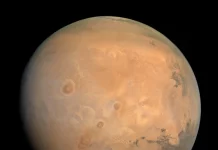
For years, mysterious dark streaks running down the slopes of Martian cliffs and craters have puzzled scientists.
Some believed these streaks, called slope streaks and recurring slope lineae (RSL), were signs that water might still be flowing on Mars.
If true, it would have been an exciting hint that life might exist in hidden, habitable pockets on the Red Planet.
But a new study led by researchers from Brown University and the University of Bern suggests that these streaks are not formed by water at all. Instead, they are likely caused by dry processes involving dust and wind.
The research, published in Nature Communications, used machine learning to analyze a massive collection of high-resolution satellite images of Mars.
Adomas Valantinas, a postdoctoral researcher at Brown, and Valentin Bickel, a researcher at Bern, led the study.
They wanted to solve the long-standing mystery of how these streaks form. Since the 1970s, when NASA’s Viking mission first captured images of the streaks, scientists have debated their origin.
Some argued that small amounts of salty water might flow down the slopes, especially during the warmer months. This theory suggested that there might still be tiny pockets of liquid water on Mars, despite its extremely cold and dry climate.
However, not everyone was convinced. Many researchers believed the streaks were caused by dry processes, such as dust slides or wind events, rather than water flows. To find out the truth, Valantinas and Bickel turned to artificial intelligence.
They trained a machine learning algorithm to identify slope streaks in satellite images. Then, they used the algorithm to scan more than 86,000 high-resolution images of Mars. The result was a global map containing over 500,000 streak features—by far the most complete map ever made.
With this map, the researchers could compare the streaks to data on temperature, wind speed, humidity, and other environmental factors.
If water were involved, the streaks would likely appear in places with signs of moisture, like high humidity or temperature fluctuations that would allow ice to melt. But that’s not what they found. Instead, the streaks were mostly found in areas with strong winds and high levels of dust.
The scientists concluded that the streaks are likely formed when layers of fine dust suddenly slide down steep slopes, triggered by things like wind gusts or shockwaves from nearby meteor impacts.
This discovery has important implications for Mars exploration. If the streaks had been caused by water, NASA would have had to be extra careful about exploring these areas to avoid contaminating them with Earth microbes. But now that scientists believe these features are dry, it reduces the worry of contaminating potentially habitable zones.
“That’s the advantage of this big data approach,” Valantinas explained. “It helps us to rule out some hypotheses from orbit before we send spacecraft to explore.”
This study adds to our growing understanding of Mars and shows how new technology like machine learning can help solve long-standing mysteries. While the hope of finding water on Mars may be dimmer for now, the findings bring us one step closer to understanding the planet’s strange and beautiful landscape.
Source: Brown University.



